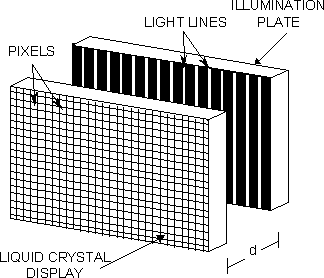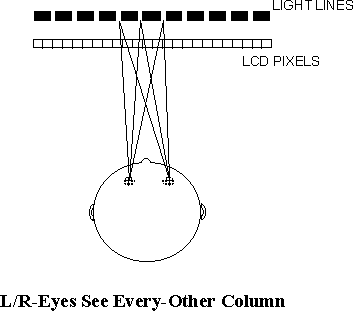DTI's Virtual Window 3D LCD Display
3D Display Technology
The basic technology for the 2015XLS is called parallax illumination. The two images - for the left eye and right eye - are sent to different columns of pixels, the left eye images to the odd numbered columns and the right eye to even numbered columns. An optical device called a TN panel is inserted between the standard LCD backlighter and the LCD panel itself, and the vertical columns on the TN panel illuminate either the even or odd columns of pixels, depending on which image is coming through. You can see this in figures 1 and 2. Your left eye sees only left eye images and your right eye sees only right eye images, just as you do in real life. This "fools" your mind into believing it is looking at a real life situation with real depth

Figure 1 (image courtesy of DTI)

Figure 2 (image courtesy of DTI)

Image courtesy of DTI
The stereo pair on alternate columns of pixels is generated at a rate of 60 frames per second, and on a 1024x768 display you end up effectively getting each image in 512 columns and 768 rows. Getting the separate images to each eye is achieved by using a lenticular lens on the TN panel. As a result, you end up a set of viewing areas where the process will work for you, as shown in Figure 3.
As a counterpoint, Cees van Berkel of Philips Research Laboratories in the UK pointed out that his company's approach is to place a lenticular lens screen in front of the display to provide multiple views (i.e. more that the minimum two you require for stereo vision). By working behind the lens DTI allows you to use their panel as a 2D LCD display in full resolution; Philips' solution doesn't. By the same token, Philips' can claim to offer a greater field of vision allowing more people to have access to the 3D image from a variety of angles, as well as maintaining full LCD brightness when 3D viewing. With DTI's approach you obviously lose some brightness because you're halving the number of columns delivering the light.
Stay On the Cutting Edge: Get the Tom's Hardware Newsletter
Join the experts who read Tom's Hardware for the inside track on enthusiast PC tech news — and have for over 25 years. We'll send breaking news and in-depth reviews of CPUs, GPUs, AI, maker hardware and more straight to your inbox.
Most Popular



